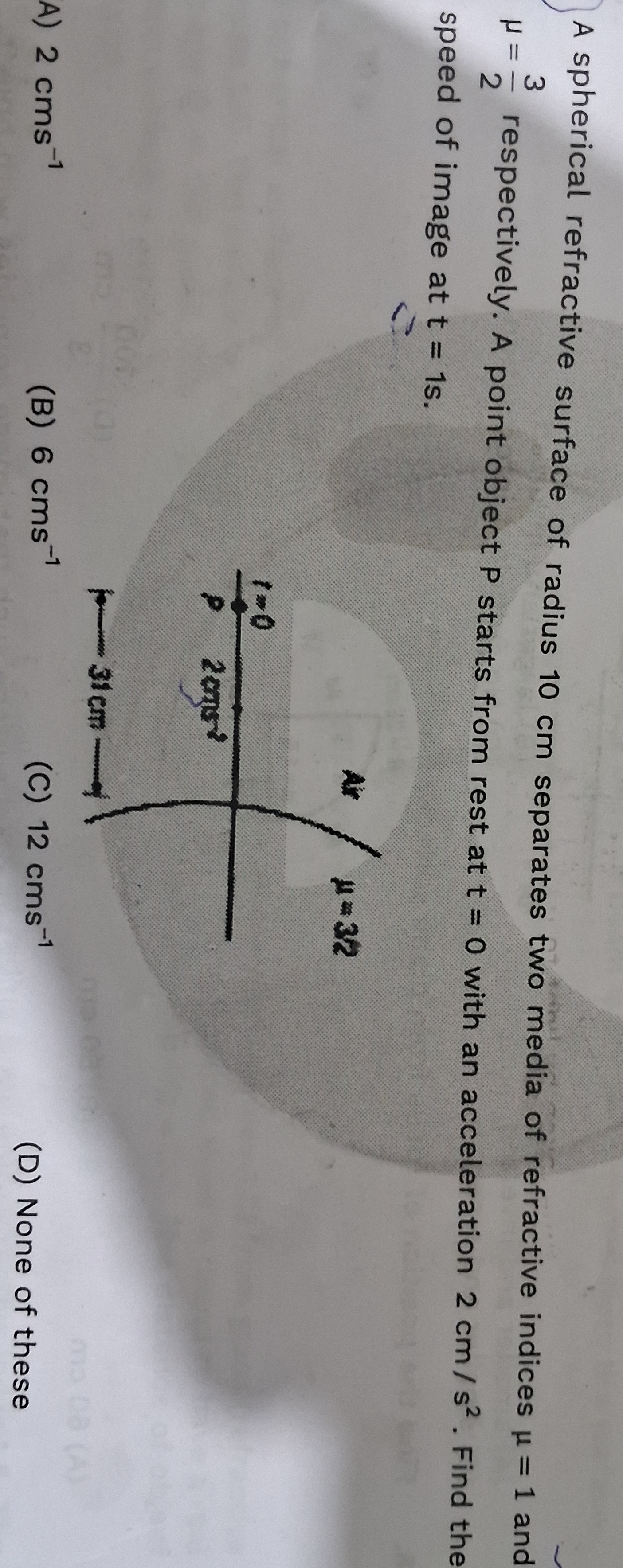Question
Question: A spherical refractive surface of radius 10 cm separates two media of refractive indices µ = 1 and µ...
A spherical refractive surface of radius 10 cm separates two media of refractive indices µ = 1 and µ = 23 respectively. A point object P starts from rest at t = 0 with an acceleration 2 cm/s². Find the speed of image at t = 1s.

2 cms⁻¹
6 cms⁻¹
12 cms⁻¹
None of these
None of these
Solution
-
Determine the object's position and velocity at t=1 s: The object starts from rest (v0=0) at t=0 with an acceleration a=2 cm/s2. Assuming the surface is at the origin and light travels from left to right, and the object is initially 2 cm from the surface, its initial position is u(0)=−2 cm. The acceleration is away from the surface, so it's in the negative direction, a=−2 cm/s2. The position of the object at time t is given by: u(t)=u(0)+v0t+21at2 u(t)=−2+(0)t+21(−2)t2=−2−t2 At t=1 s, the object's position is: u(1)=−2−(1)2=−3 cm. The velocity of the object at time t is: vobject(t)=v0+at=0+(−2)t=−2t At t=1 s, the object's velocity is: vobject(1)=−2(1)=−2 cm/s.
-
Calculate the image position at t=1 s: Using the spherical refractive surface formula: vμ2−uμ1=Rμ2−μ1 Given: μ1=1, μ2=3/2, R=+10 cm, and u=−3 cm. v3/2−−31=103/2−1 2v3+31=101/2=201 2v3=201−31=603−20=−6017 v=23×(−1760)=−1790 cm.
-
Calculate the image velocity at t=1 s: Differentiate the refractive surface formula with respect to time t: μ2dtd(v1)−μ1dtd(u1)=0 −v2μ2dtdv+u2μ1dtdu=0 Let vimage=dtdv and vobject=dtdu. −v2μ2vimage+u2μ1vobject=0 vimage=μ2μ1u2v2vobject Substitute the values at t=1 s: u=−3 cm, v=−90/17 cm, vobject=−2 cm/s, μ1=1, μ2=3/2. vimage=3/21(−3)2(−90/17)2(−2) vimage=329(90/17)2(−2) vimage=3298100/289(−2) vimage=32289900(−2)=−2891200 cm/s.
-
Find the speed of the image: The speed of the image is the magnitude of its velocity: Speed =∣vimage∣=−2891200=2891200 cm/s. Calculating the numerical value: 2891200≈4.152 cm/s.
Since this value is not among the options A, B, or C, the correct option is (D) None of these.
